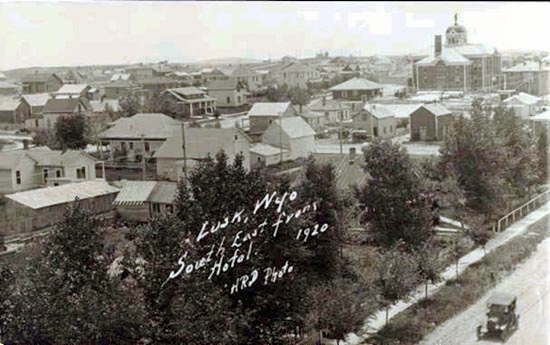
Looking Southeast from Hotel, 1920. Photo by
H. R. Daniels.
H. R. Daniels was a jeweler from Douglas.
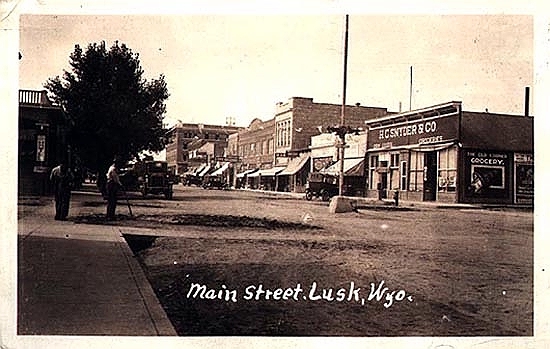
H. C. Snyder's store, Main Street, 1924.
Harry C. Snyder and his wife, Mary V. Snyder, arrived in the area before the
turn of the century. Snyder, in addition to his support for
the formation of Niobrara County, was a member of the Good Roads Club. He, additionally, among other things, donated the land upon which
St. Leo's Catholic Church was constructed. Mrs. Snyder served as
Grand Worthy Matron in the Order of the Eastern Star.
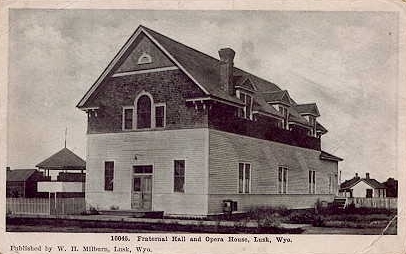
Lusk fraternal hall and opera house. The building later burned.
Lusk was founded in 1886, the year before
the discontinuance of the Cheyenne-Deadwood Stage Line discussed on a
previous page. A settlement had originally been located
a few miles west near the Silver Cliff Mine. When the railroad came in 1886, Frank S. Lusk (1857-1930),
a local rancher, owned the land upon which the town was to be located.
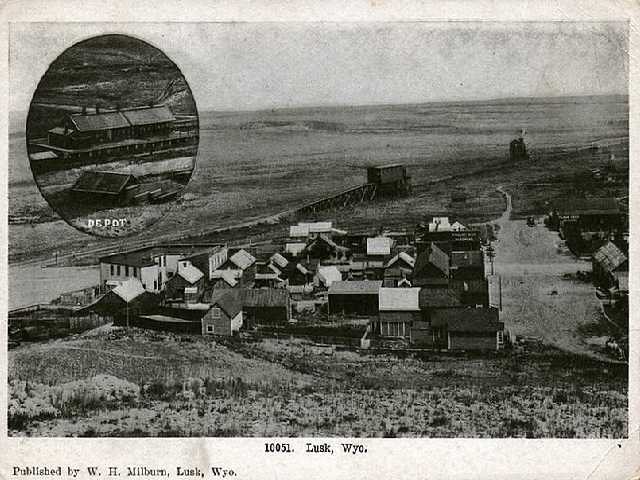
Lusk, circa 1918, looking east
On left is the Northwestern Hotel. The broad street running away from
the viewer is present day East 2nd Street. The depot was rebuilt in 1919. The Water tank was moved at that time from its original location.
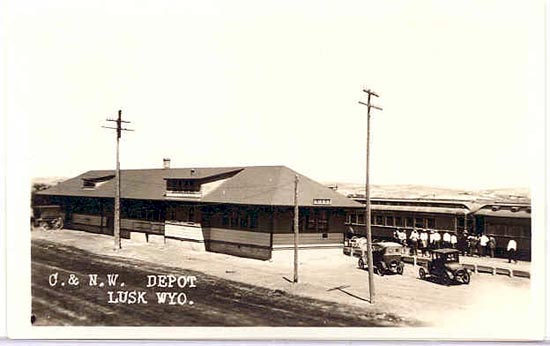
Lusk Depot, approx. 1920
Henry Lusk came west at age 19 and entered the
cattle business in Colorado, but in 1880 moved his operations, the Western Live Stock Company, to
Node fifteen miles east of present-day Lusk. He later acquired land near the stage station at
Running Water. About 1884, Luke Voorhees, manager of the Cheyenne & Black Hill Express Company, applied for
a post office and named it after Lusk. Henry Lusk, however, acted as the first
postmaster. Henry Lusk became a railroad contractor and by 1910 had sold his real estate interests
in the area off to Tom Bell, L. J. Lohlein, and Harry Snyder and had moved to
Missoula, Montana, where he owned a bank.
For technical legal reasons when the railroad came, the right-of-way was required to be
owned by a corporation incorporated within the Territory. Since the only post office along the route of
the railroad was at Lusk, the town was born as the legal headquarters for the
Wyoming Central Railway which leased the line to the Fremont, Elkhorn & Missouri Valley Railway.
The Wyoming Central and The Fremont, Elkhorn & Missouri Valley were
consolidated in 1891. The railroad was purchased by the Chicago & Northwestern in 1903.
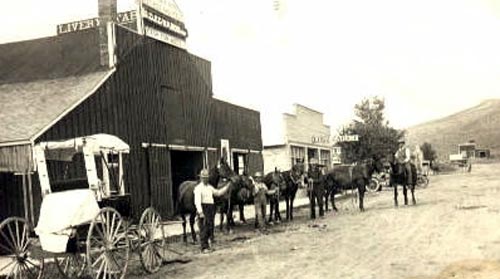
Livery, undated.
Note motorcar behind horses.
As with many "end of the line" towns, Lusk was
during its formative years a tad rough, Professor Larson referring to it as a
"miniature" hell on wheels, "without vigilantes." (Larson, 2nd ed, revised, p. 160.) An early example is the
tale of an individual known as the "stranger," and referred to by Justice Cole of the
Territorial Supreme Court simply as the "deceased." On October 9, 1886, the Stranger arrived in
town and booked his horse into Reddington's livery and then proceeded to imbibe at several of
the town's watering holes. At Johnny Owens' establishment, the Stranger apparently attempted to
impress one of the girls with the information that he was a horse thief and part of a gang camped about
four miles out of town. The girl imparted this information to Town Marshal Charles Trumbull who took the
Stranger into custody and convened a posse to capture the gang suspected of rustling horses in Johnson County.
When the gang could not be found, Trumble commenced to whip the Stranger and
threated to hang him from the water tank unless he would reveal the location of the
gang. At this point, the Stranger sobered up, revealed that the story of the gang was a josh, that his horse
was in the livery with a correct brand. When the Stranger's story checked
out, Johnny Owens urged Trumble to release the Stranger, couldn't Trumble tell that the
Stranger was only drunk? There then followed, apparently as a form of apology for the Stranger's
mistreatment, a tour of the town's drinking establishments with the tour ending at
Whittaker's Saloon. By then,
Trumble was quite drunk and asked the Stranger if he was friend or an enemy. After the
Stranger gave a somewhat noncommittal answer, in the words of Justice Cole:
Trumble drew a revolver, and pointed it at the deceased, working the hammer
back and forth, and again repeated his question and the deceased said: "I will have
to be a friend to you now." Trumble then told the deceased he was a coward, again raised
his pistol, and asked if he was a friend. The deceased said: "Do you want the truth? Well,
Charley, I don't like you."
Whereupon, Charley Trumble shot the Stranger dead. Charley was convicted of first degree murder and sentenced to
hang. Trumble
appealed on the basis that the judge gave an erroneous instruction as to malice. He also argued that the
conviction was fatally flawed in that Trumble was indicted by the Grand Jury for murdering one
Charley Miley. No one really knew who the Stranger was. Thus, the allegata
was inconsistent with the probata and, in legal contemplation, Trumble was not guilty. We all know that a legal contemplation is a
serious thing [Apologies to Sir Wm. Gilbert, The Gondoliers, 1889, "A legal fiction is a serious thing."] The
argument simply was Trumble was charged with killing Charley Miley. Even though the prosecution
proved that there was a dead body on the floor of Whittaker's and that Trumble did it,
, the prosecution did not
prove that the body was that of Charley Miley as charged.
Various witnesses admitted that they really did not know who the Stranger was, he being referred to at the
trial as Charley Miley, the "Prisoner," Gilliand, "Red Bill," "Gunny Sack Bill," and
Pete Gilmore. The Supreme Court did not buy the argument. The Court could not ignore the fact that all agreed that
Trumbull did the dirty deed.
Nevertheless, the Supreme Court did agree that the judge's instruction to the
jury as to malice was defective and remanded for a new trial. Trumble pleaded guilty to manslaughter and was
sentenced to six years at Laramie with three years credit for time served.
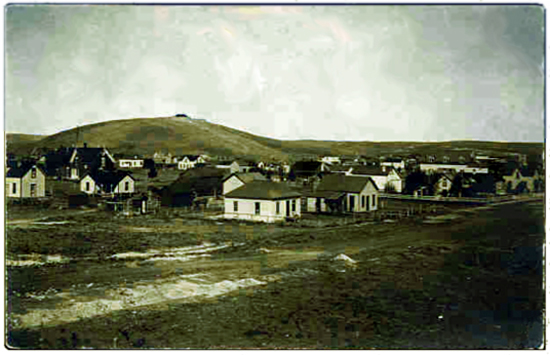
Lusk, undated
Johnny Owens, in whose establishment the fatal adventures of the Stranger commenced, was one of Wyoming’s more interesting characters.
He came up the Trail from Texas prior to 1870. Owens operated a ranch at Chug Springs outside of Bordeaux.
In the 1880’s, he took over operation of the Hog Ranch at Fort Laramie. By 1886, the good times at Fort Laramie beginning to wind down.
With the coming of the railroad, Lusk, became the hot town. Thus,
Johnny opened his establishment in Lusk. With the extension of the
railroad to Casper, Lusk cooled down. In 1890, Owens moved on to Newcastle.
There, Johnny opened a dancehall and saloon locally
referred to as the “House of Blazes.” Legend in Newcastle is that the name referred to the number of gunfights which broke out within the saloon.
Whether the same is true or not is in reality unknown. The term “House of Blazes” was commonly used in the mid-Nineteenth Century to refer to a
saloon or other establishment with a reputation as a “hellhole.” In San Francisco one such facility was
operated by a Madam Johanna Schriffin. On one occasion a policeman had the temerity to follow
a thief into Madam Johanna’s establishment. Before the officer of the law could escape, the inmates and customers
had relieved him of his handcuffs, pistol, cap, and blackjack.
In the Hell’s Kitchen area of New York, another House of Blazes allegedly received its name because drunken patrons
would be set on fire for the amusement of the damsels within.
In New York another House of Blazes at 5 Batavia Street was a flop house Extraordinaire. The proprietor would fit
in each room some 12 guests in a 13 x 13 space, half in three bunks and half on the floor.
But then, the proprietor only charged a nickel a night for a spot.
Not withstanding Johnny Owens' ownership of the House of Blazes, or maybe because of it, Owens was elected as
sheriff of Weston County in 1892.
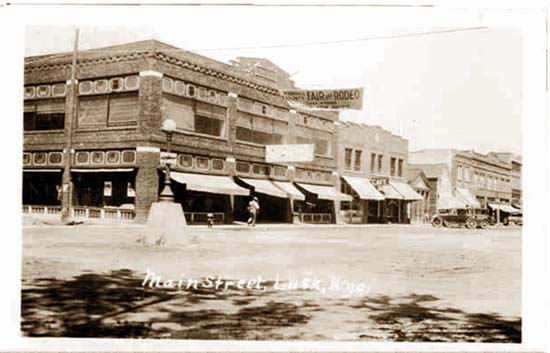
Main Street, 1920's.
During its "Hell on Wheels" days, the shooting of the Stranger was not the only shooting in Lusk. Four months later, Deputy Sheriff Charles
S. Gunn was shot to death in Jim Waters' Saloon by Bill McCoy. At the time Lusk was in Laramie County and, therefore, McCoy was taken to
Cheyenne for trial. He was found guilty of first degree murder and sentenced by Judge Samuel T. Corn to hang. He escaped from the
jail by filing through the bars with a hacksaw blade that had been concealed in the soles of another inmate's shoes. This, however,
was not the first time that McCoy had averted the hangman's noose by an escape. Unknown to Wyoming lawmen McCoy's real name was
Dan Bogan. Bogan when he had been drinking tended to become belligerent. Indeed, his belligerency when drinking is what got him in trouble with
Deputy Gunn. The two earlier had a confrontation in the Cleveland Brothers' Saloon.
In 1881 in Hamilton, Texas, Bogan had been drinking with a
friend, Davy Kemp. Bogan got into a confrontation with F.A. "Doll"Smith when Bogan refused to move his horse which
was blocking Smith's wagon parked near Cropper's store. Words led to a physical fight which led to some five shots being fired in the direction
of Smith. Smith did not attempt to fire his gun. The fifth shot hit its mark. Within minutes Smith was dead. Bogan and Kemp were charged
with murder in the first degree, a capital offense. Upon conviction Bogan and Kemp exited the courthouse by leaping out the
window. Kemp broke his leg in the leap and was recaptured. On an appeal, Kemp v. State, 11 Texas Court of Appeals, 174 (1881), the court held that Kemp was only
helping Bogan and, therefore, he did not have the necessary degree of malice to warrant hanging. Later,
Kemp was pardoned and became a sheriff in New Mexico. Bogan made good his escape, changed his name to W. A. Gatlin and continued his adventures in the
area of Tascosa, Texas. Tascosa, at the time, was where the cattle trail leading to Caldwell, Kansas, crossed the Canadian. Thus, it was amply supplied
with saloons. In 1886, Tascosa was the scene of the "Big Fight," a glorious five-minute shoot-out which started when Ed King, an L S cowboy, and
Lem Woodruff, a part-time bartender and former L S. Cowboy, vied for the affection of Sally Emory, apparently a lady of loose virtue. Four, including Ed King, were killed. Lem Woodruff and a cowboy,
John B. Gough, "the Catfish Kid" were severely wounded. The Catfish Kid received his sobriquet as a result of the perceived
resemblance of his eys to those of a fish.
After Bogan's escape from the Cheyenne jail, a posse was organized by Laramie County sheriff Seth Sharpless; Albany County Deputy Sheriff
Malcolm Campbell; former Albany County sheriff and Wyoming Stock Growers Association Chief of
Detectives Nathaniel K. Boswell; and stock detective Frank Canton. The posse suspected that Bogan may have taken refuge on the Keeline
ranch outside of Lusk. Unbeknownst to his fellow members of the possee, Canton, himself, was wanted under a different name in
Texas. See Johnson County War. There may have been good reason for their suspicions of Keeline involvement. Reputedly many, if not all, of the
range riders for the Keeline had notches on their guns and were wanted in Texas. The posse was unsuccessful.
Prosecuter Walter Stoll, who later
prosecuted Tom Horn, called in the Pinkertons who assigned Charles Siringo to the case. Siringo, pretending to be a wanted outlaw himself,
gained the confidence of the Keeline riders but learned that Bogan had already taken off for Utah on the Keeline foreman's, favorite horse. From Utah,
Bogan returned to Tascosa stopping off on the way at Los Portales Lake to see Woodruff whom Bogan had known from when the two
participated in a cowboy strke. From there, Bogan travelled to
to New Orleans and then sailed to Argentina. Unknown at the time, but learned later, was that the Keeline foreman, Tom Hall, was
himself, wanted in Texas for murder under his real name of John "Tom" Nichols. Years later it was learned that Hall arranged for the hacksaw blade to be
sneaked into the Cheyenne jail and that he had arranged for the gettaway horse outside the jail. Hall ultimately moved to
Price, Utah, where he ran a saloon under his real name. Nichols, had a brother William M. "Mid" Nichols who at one time
ran a saloon in Baggs, Wyoming. In Baggs, Mid Nichols helped conceal Butch Cassidy. Later Mid moved to Pioche, Nevada, where he also
operated a saloon. Siringo suspected that Bogan changed his name once again and returned to the
United States.
Next page: Lusk Continued.
|